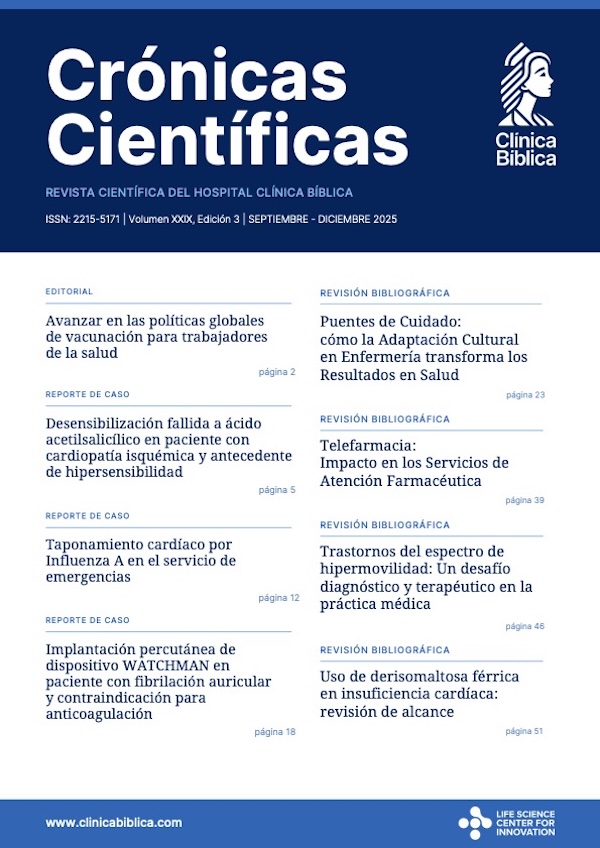- Visto: 1103
Revisión Bibliográfica
Manejo del hipotoroidismo subclínico
Management of subclinical hypothyroidism
Edición XII Mayo - Agosto 2019
DOI: https://doi.org/10.55139/IUYV6145
APA (7ª edición)
Rojas-Bermúdez, C. (2019). Manejo del Hipotiroidismo. Crónicas Científicas, 12(12), 58-64. https://doi.org/10.55139/IUYV6145.
Vancouver
Rojas-Bermúdez C. Manejo del Hipotiroidismo. Cron Cient. 8 de marzo 2019;12(12): 58-64.
Dr. Christopher Rojas Bermúdez
Investigador independiente.
Miembro del Colegio de Médicos y Cirujanos de Costa Rica.
Costa Rica.
Resumen
El hipotiroidismo subclínico es un hallazgo de laboratorio muy común en la práctica médica. Su manejo puede variar según el grupo poblacional con que se esté tratando. De estos grupos, los más importantes de tener en cuenta son las mujeres con deseo de procreación, embarazadas y la persona adulta mayor. Como aspecto práctico se recomienda valorar en todos los pacientes el riesgo de recurrencia, niveles de TSH y los beneficios /efectos adversos del tratamiento. Los principales factores de recurrencia son el nivel de TSH y la presencia de anticuerpos contra peroxidasa tiroidea positivos. En la población general adulta, la elevación de TSH debe ser sostenida por más de 3 meses antes de iniciar tratamiento.
Son claros el beneficio y la evidencia de tratar a pacientes con TSH mayor de 10 mlU/L con dosis de 25-75 μg día si no existe enfermedad cardiovascular; si fuera así, las dosis son menores. La meta es alcanzar rangos normales de TSH. En pacientes con valores de TSH por encima del rango superior normal hasta 10 ml/L existe mucha controversia sobre el manejo, aunque la tendencia y evidencia más recientes recomiendan el manejo expectante. De manera general en los casos en que no se decida tratar, se debe evaluar los niveles hormonales en 6 meses – 1 año.
La excepción a estas recomendaciones son las mujeres embarazadas y con deseos de procrear, debido a que representan casos particulares que dependen de otros factores.
Palabras claves
Hipotiroidismo, embarazo, subclínico, levotiroxina, infertilidad, anticuerpos, peroxidasa, niños, adulto mayor.
Abstract
Subclinical hypothyroidism is a very common lab pattern in medical practice. Its management depends on the type of population that´s being attended. On those different population groups, the ones that require especial attention are pregnant women, women who want to procreate and the elderly. As a practical approach, its recommended to evaluate in all patients the recurrence rates, TSH levels benefits/adverse effects of treatment. The major recurrence factors are the TSH levels and the presence of positive thyroidal antiperoxidase antibodies . On general adult population TSH levels should be elevated at least for 3 months to consider treatment.
The benefit and evidence of treating patients with TSH levels over 10 mlU/L is clear with doses of levothyroxine from 25-75μg/day unless there is cardiovascular disease present, in which case doses should be lower. The goal is to achieve normal TSH ranges. Treatment in patients with TSH levels between 10 mu/L and the normal superior range is controversial. The evidence suggests and supports expectant management. In all patients who do not receive treatment, should be monitorized with hormonal levels measured in a 6 month -1 year term.
Pregnant women and those who are searching for pregnancy are the exception to this recommendation because they represent unique cases which depend on other factors.
Keywords
Hypothyroidism, pregnacy, subclinic, levothyroxine, infertility, antibodies, peroxidase, children, elderly.
Bibliografía
Agustín, A. (2017). Hipotiroidismo subclínico en el adulto mayor. Actualización Médica Periódica Costa Rica , 1-4.
Alexander, E.K.; Pearce, E.N.; Brent, G.A., et al. (2017). Guidelines of the American Thyroid Association for the diagnosis and management of thyroid disease during pregnancy and the postpartum. Thyroid. 27 (3), 315–389.
Garber, J.R.; Cobin, R.H.; Gharib, H.; Hennessey, J.V.; Klein, I.; Mechanick, J.I., et al. (2012). Clinical practice guidelines for hypothyroidism in adults: cosponsored by the American Association of Clinical Endocrinologists and the American Thyroid Association. Endocr Pract. 18, 988–1028.
Gregory, A.; Brent, A. P. (2016). Hypothyroidism and Thyroiditis. Por K. S. Shlomo Melmed, Williams Textbook of Endocrinology. (417-442). Philadelphia: Elsevier.
Hennessey, J.V.; Espaillat, R. (2015). Diagnosis and management of subclinical hypothyroidism in elderly adults: a review of the literature. J Am Geriatr Soc. 63, 1663-73.
Hennessey, J.V.; Espaillat, R. (2015). Subclinical hypothyroidism: a historical view and shifting prevalence. Int J Clin Pract. 69, 771-82.
Herrera Pombo, J.L. (2008). Hipotiroidismo. Medicine. 10 (14), 922-9.
J. Larry Jameson, S. J. (2018). Hypothyroidism. Por D. L. J. Larry Jameson, Harrison´s Principles of Internal Medicine, 19e. (2698-2703). New York: McGraw-Hill Education.
Jonklaas, J.; Bianco, A.C.; Bauer, A.J.; Burman, K.D.; Cappola, A.R.; Celi, F.S.; Cooper, D.S.; Kim, B.W.; Peeters, R.P.; Rosenthal, M.S.; Sawka, A.M. (2014). American Thyroid Association Task Force on Thyroid Hormone Replacement . Guidelines for the treatment of hypothyroidism: prepared by the American Thyroid Association Task Force on Thyroid Hormone Replacement. Thyroid. 24 (12), 1670–1751.
Somwaru, L.L.; Rariy, C.M.; Arnold, A.M.; Cappola, A.R. (2012). The natural history of subclinical hypothyroidism in the elderly: the Cardiovascular Health Study. J Clin Endocrinol Metab. 97(6). 1962–1969. PMID: 22438233, 10.1210/jc.2011-3047.
Stott, D.J.; Rodondi, N.; Kearney, P., et al. (2017). For the TRUST Study Group. Thyroid hormone therapy for older adults with subclinical hypothyroidism. N Eng J Med. 376, 2534-44.
APA (7ª edición)
Rojas-Bermúdez, C. (2019). Manejo del Hipotiroidismo. Crónicas Científicas, 12(12), 58-64. https://doi.org/10.55139/IUYV6145.
Vancouver
Rojas-Bermúdez C. Manejo del Hipotiroidismo. Cron Cient. 8 de marzo 2019;12(12): 58-64.
Esta obra está bajo una licencia internacional Creative Commons: Atribución-NoComercial-CompartirIgual 4.0 Internacional (CC BY-NC-SA 4.0)

Realizar búsqueda
Última Edición
Ediciones Anteriores






